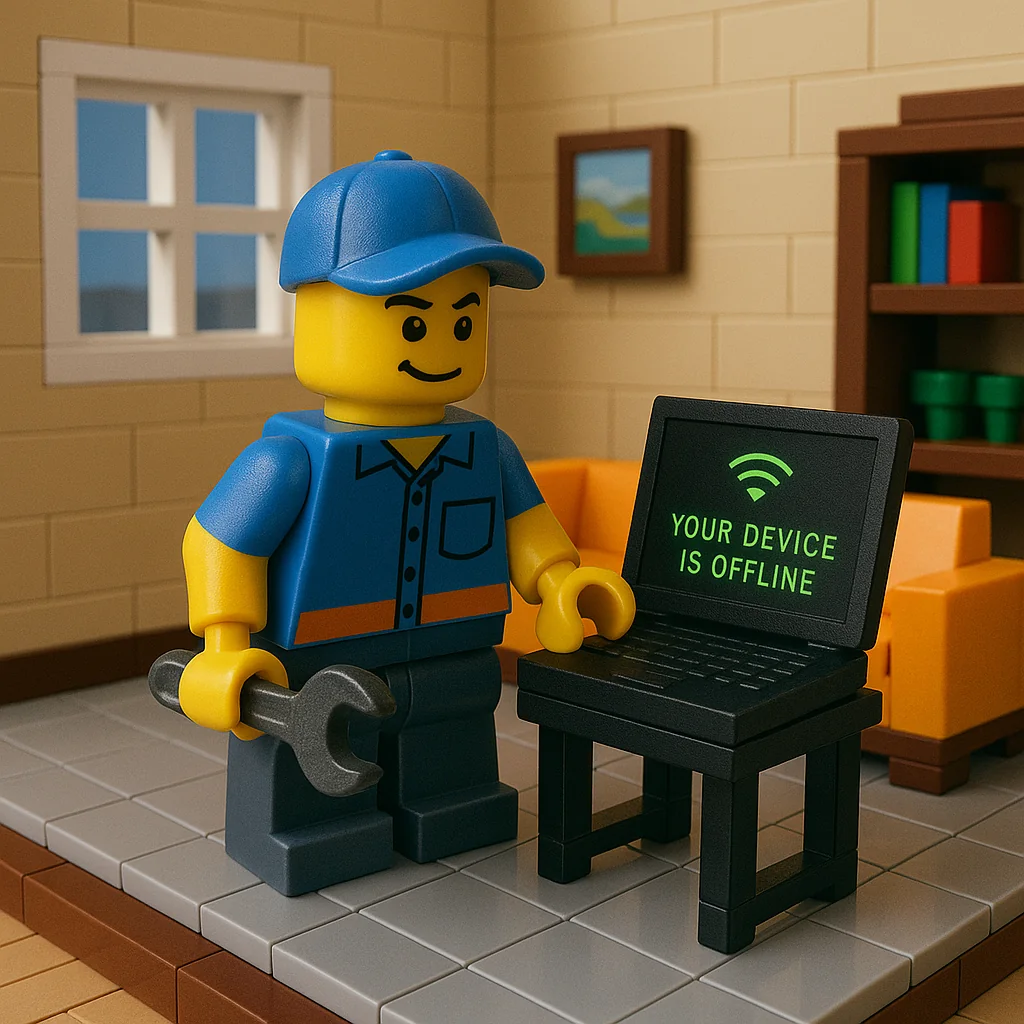Why does my computer say ‘Your device is offline’?

Table of Contents
Likely causes:
- Windows using cached sign-in and refusing without network; switch to a local sign-in temporarily.
- Adapter disabled or in airplane mode.
- Router DHCP hiccups; renew IP or reboot the router.
- Captive portal on guest Wi-Fi blocking access.
- Date/time drift breaking SSL and logins.
Need help? Check here: /services/house-calls/
What it might be (likely causes)#
Microsoft account sign‑in needs a network
When Windows thinks you must re‑authenticate a Microsoft account, it can block login if there’s no internet or SSL fails. A temporary local account login can get you in to fix networking.Radio off / airplane mode
A single Fn key or toggle can disable Wi‑Fi/BT. Laptops and small desktops do this often; check the quick settings pane.DHCP / router hiccup
If your PC has an APIPA address (169.254.x.x), it didn’t get an IP from the router. Renewing the lease or rebooting the router usually clears this. Sane small‑town router defaults: /posts/router-settings-small-town/Captive portal in the way
Guest Wi‑Fi at coffee shops, hotels, or even some ISP gateways require a captive portal click‑through before you get real internet. Background: Captive portalBad time/SSL
Large date/time drift breaks certificates and logins, making Windows think “offline.” Fix time sync first. Background: Network Time ProtocolDNS/proxy leftovers
A stuck proxy or bad DNS server can make the web look “down” from this PC only. Resetting Winsock/DNS often restores reachability. Local provider context: /posts/isps-in-kirksville/
Things to check (quick, safe wins)#
Try a local sign‑in (if you see the login screen)
If your Microsoft account fails, click Sign‑in options → choose PIN/Password. If you also have a local account, sign into that. Once at the desktop, fix networking below.Verify radio & airplane mode
- Press
Win + A→ ensure Airplane mode is Off and Wi‑Fi is On. - Hardware toggle: many laptops use Fn + (antenna icon). On desktops, check Ethernet link light.
- Press
Renew IP & reset the stack
Open PowerShell (Admin) and run:ipconfig /release ipconfig /flushdns ipconfig /renew netsh winsock resetThen reconnect to Wi‑Fi/Ethernet and test again. If Wi‑Fi is unstable indoors, see placement tips: /posts/kirksville-wifi-dead-zones/
Open the captive portal
If you’re on guest Wi‑Fi, try visitinghttp://neverssl.com/to trigger the portal page. Complete the login/agree step, then retry apps.Force a clean DNS
Set the adapter’s DNS to a known good resolver (e.g., Cloudflare 1.1.1.1 or Quad9 9.9.9.9) and retest. If the issue vanishes, your old DNS was the culprit.Time sync
- Right‑click the clock → Adjust date and time → enable Set time automatically and Set time zone automatically → Sync now.
- Or run:
w32tm /resyncNetwork profile sanity
Ensure the current network is Private (not Public) if you need discovery/SMB printing. Updates sometimes flip this. Discovery basics are in the printer guide: /posts/why-cant-my-computer-connect-to-the-printer-after-a-windows-update/Last resort: create a temporary local account
If you’re hard‑locked, boot to Safe Mode with Networking, create a local admin, log in, and repair the network path. General boot mindset: /posts/the-art-of-making-things-boot/
Patterns that point to the cause#
- 169.254.x.x address → DHCP failure; router or Wi‑Fi association issue.
- Only web pages fail but ping by IP works → DNS problem; set clean DNS.
- Portal shows on phone but not PC → cached DNS/proxy; reset stack or hit a plain HTTP site to trigger.
- Clock is wildly wrong → SSL handshake fails; sync time first.
- Wi‑Fi sees the SSID but won’t join → band/security mismatch; check settings here: /posts/router-settings-small-town/
When to pause and get hands‑on help#
- You’re repeatedly thrown back to the login screen with “device is offline.”
- The NIC shows errors or disappears in Device Manager (possible driver/hardware fault).
- Captive portals never load despite resets (layer‑7 filtering, DNS hijack, or firewall rules).
An on‑site survey—stack reset, DNS cleanup, and a router sanity pass—usually restores predictable connectivity fast.
Insight#
“Offline” can be a lie told by one broken link: radio → DHCP → DNS → SSL → account token. Fix them in that order. Once the basics (IP, DNS, time) are clean, sign‑ins stop failing mysteriously. Predictable networking is built on explicit choices: known SSIDs, sane DHCP/DNS, and time that matches the universe.
Need a steady hand in Kirksville—stack reset, captive‑portal wrangling, or small‑office router tuning?
See /services/house-calls/.